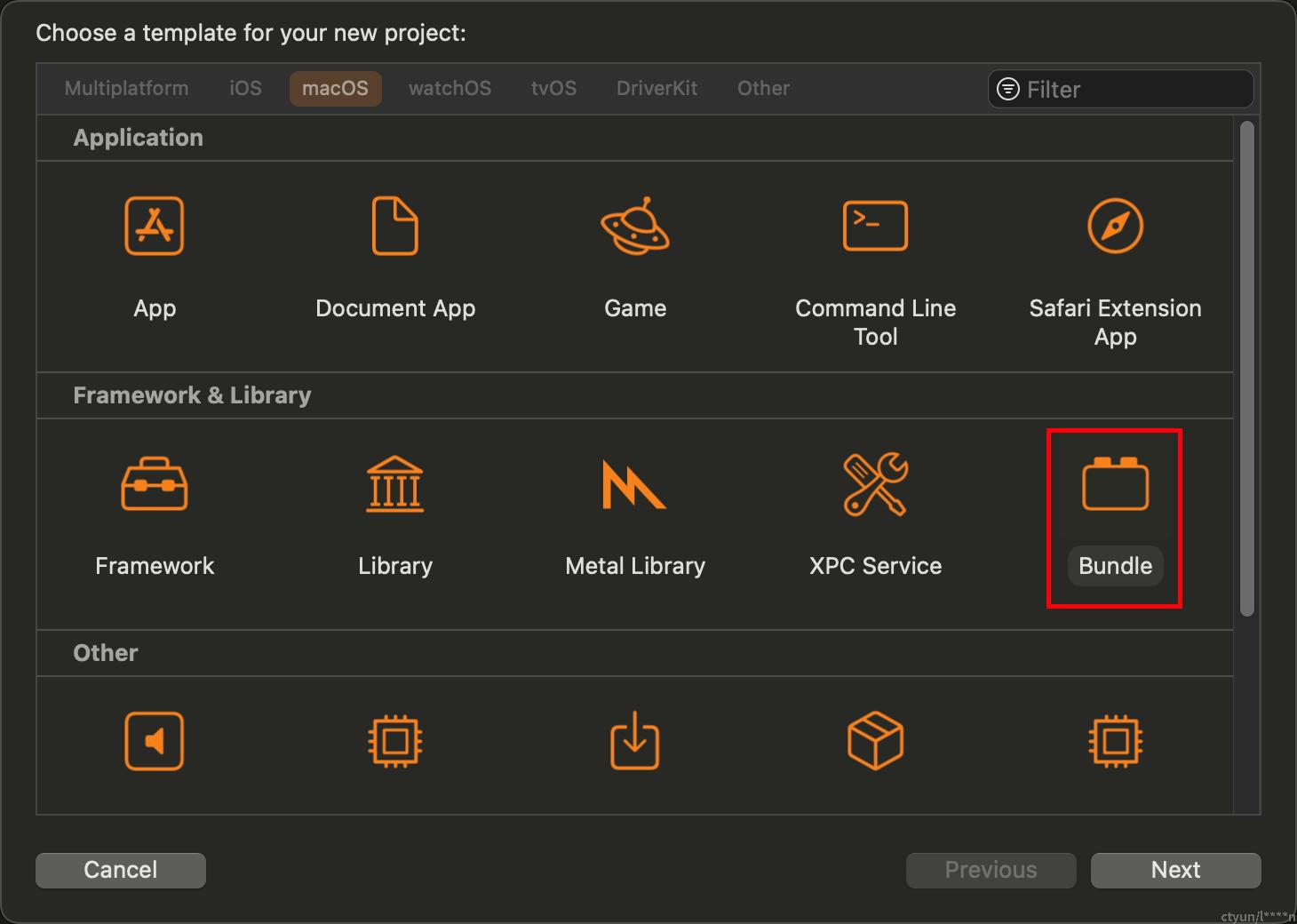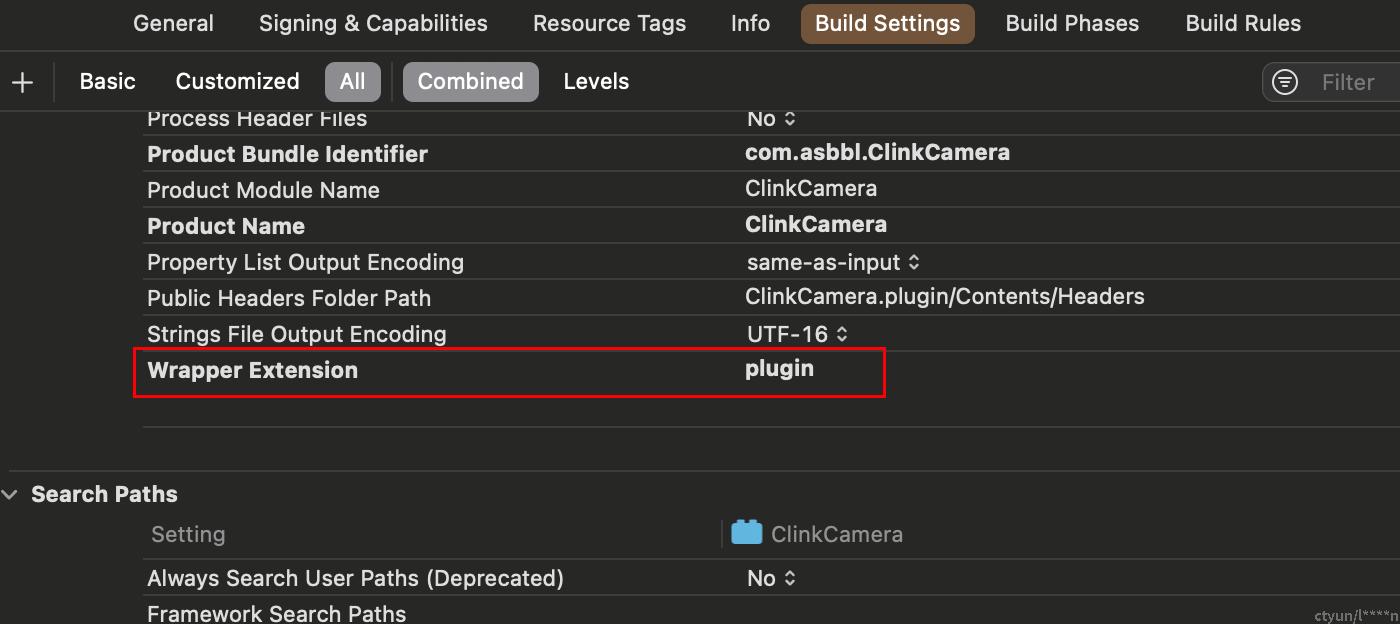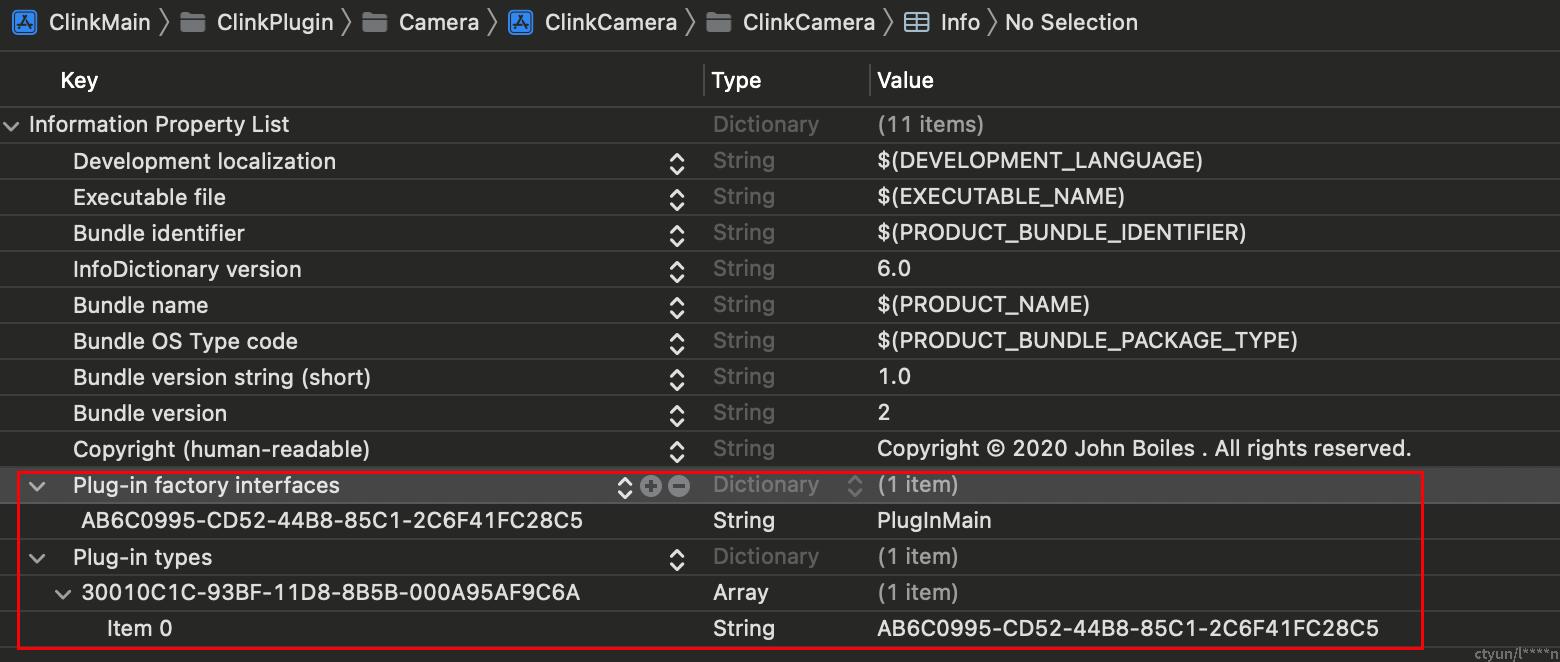通过实现HAL插件可以实现虚拟摄像头插件,其中HAL意思是“Hardware Abstract Layer”,即硬件抽象层的意思。HAL插件的实现主要是使用CoreMediaIO.framework,这个框架提供了HAL插件的结构定义和接口声明,我们只需要按照约定声明和实现相关接口即可。
1. 首先创建类型为“Bundle”的工程(HAL插件都是以Bundle的格式打包):

2. 修改“Wrapper Extension”为“plugin”(HAL插件安装包后缀名均为plugin)

3. 接下来需要使用自定义的Info.plist文件,并且需要配置Plugin的入口函数:

其中“Plug-in factory interfaces”的Key为随机生成的UUID串,其Value为入口函数的名称,这个入口函数应该是一个C接口,比如:
extern "C" {
void* PlugInMain(CFAllocatorRef allocator, CFUUIDRef requestedTypeUUID) {
if (!CFEqual(requestedTypeUUID, kCMIOHardwarePlugInTypeID)) {
return 0;
}
return PlugInRef();
}
}“Plug-in types”用于表示HAL插件的类型,其中Key为固定值“kCMIOHardwarePlugInTypeID”,该值在<CoreMediaIO/CMIOHardwarePlugin.h>文件中定义,其Value为入口函数对应的UUID。
4. 实现插件接口
我们需要实现的是流媒体设备插件,因此需要实现的接口列表如下:
static CMIOHardwarePlugInInterface sInterface = {
// Padding for COM
NULL,
// IUnknown Routines
(HRESULT (*)(void*, CFUUIDBytes, void**))HardwarePlugIn_QueryInterface,
(ULONG (*)(void*))HardwarePlugIn_AddRef,
(ULONG (*)(void*))HardwarePlugIn_Release,
// DAL Plug-In Routines
HardwarePlugIn_Initialize,
HardwarePlugIn_InitializeWithObjectID,
HardwarePlugIn_Teardown,
HardwarePlugIn_ObjectShow,
HardwarePlugIn_ObjectHasProperty,
HardwarePlugIn_ObjectIsPropertySettable,
HardwarePlugIn_ObjectGetPropertyDataSize,
HardwarePlugIn_ObjectGetPropertyData,
HardwarePlugIn_ObjectSetPropertyData,
HardwarePlugIn_DeviceSuspend,
HardwarePlugIn_DeviceResume,
HardwarePlugIn_DeviceStartStream,
HardwarePlugIn_DeviceStopStream,
HardwarePlugIn_DeviceProcessAVCCommand,
HardwarePlugIn_DeviceProcessRS422Command,
HardwarePlugIn_StreamCopyBufferQueue,
HardwarePlugIn_StreamDeckPlay,
HardwarePlugIn_StreamDeckStop,
HardwarePlugIn_StreamDeckJog,
HardwarePlugIn_StreamDeckCueTo
};
4.1 HardwarePlugIn_QueryInterface,需要在该接口返回我们的插件实现,当有第三方应用加载我们插件的时候会调用该接口,我们需要为自己的插件实现增加一次引用:
*interface = NULL;
CFUUIDRef cfUuid = CFUUIDCreateFromUUIDBytes(kCFAllocatorDefault, uuid);
CFStringRef uuidString = CFUUIDCreateString(NULL, cfUuid);
CFStringRef hardwarePluginUuid = CFUUIDCreateString(NULL, kCMIOHardwarePlugInInterfaceID);
if (CFEqual(uuidString, hardwarePluginUuid)) {
sRefCount += 1;
*interface = PlugInRef();
return kCMIOHardwareNoError;
}
return E_NOINTERFACE;4.2 HardwarePlugIn_InitializeWithObjectID,初始化接口,在这个接口我们需要完成初始化的动作,关键是要创建Device、Stream并发布Device:
OSStatus error = kCMIOHardwareNoError;
CMIOObjectID deviceId;
// 创建设备对象
error = CMIOObjectCreate(PlugInRef(), kCMIOObjectSystemObject, kCMIODeviceClassID, &deviceId);
if (error != noErr) {
DLog(@"CMIOObjectCreate Error %d", error);
return error;
}
CMIOObjectID streamId;
// 创建多媒体流对象
error = CMIOObjectCreate(PlugInRef(), deviceId, kCMIOStreamClassID, &streamId);
if (error != noErr) {
DLog(@"CMIOObjectCreate Error %d", error);
return error;
}
// 发布设备对象
error = CMIOObjectsPublishedAndDied(PlugInRef(), kCMIOObjectSystemObject, 1, &deviceId, 0, 0);
if (error != kCMIOHardwareNoError) {
DLog(@"CMIOObjectsPublishedAndDied plugin/device Error %d", error);
return error;
}
// 发布多媒体流对象
error = CMIOObjectsPublishedAndDied(PlugInRef(), deviceId, 1, &streamId, 0, 0);
if (error != kCMIOHardwareNoError) {
DLog(@"CMIOObjectsPublishedAndDied device/stream Error %d", error);
return error;
}接下来就是关于Stream的几个接口:
4.3 HardwarePlugIn_StreamCopyBufferQueue,返回帧数据的缓存队列,第三方程序通过该队列获取帧数据;
4.4 HardwarePlugIn_DeviceStartStream,开始流传输,我们在这个接口开始视频流的生成并放到缓存队列;
4.5 HardwarePlugIn_DeviceStopStream,停止流传输;
我们可以把所有Stream相关的接口实现封装到一个独立的Stream类里面:
// 帧数据队列
- (CMSimpleQueueRef)queue
{
if (_queue == NULL) {
// Allocate a one-second long queue, which we can use our FPS constant for.
OSStatus err = CMSimpleQueueCreate(kCFAllocatorDefault, FPS, &_queue);
if (err != noErr) {
DLog(@"Err %d in CMSimpleQueueCreate", err);
}
}
return _queue;
}
// 该接口将队列返回给第三方应用,并且通过alteredProc通知数据变化
- (CMSimpleQueueRef)copyBufferQueueWithAlteredProc:(CMIODeviceStreamQueueAlteredProc)alteredProc alteredRefCon:(void *)alteredRefCon
{
self.alteredProc = alteredProc;
self.alteredRefCon = alteredRefCon;
// Retain this since it's a copy operation
CFRetain(self.queue);
return self.queue;
}
// 往队列中填充视频帧数据
- (void)queueFrameWithSize:(NSSize)size timestamp:(uint64_t)timestamp fpsNumerator:(uint32_t)fpsNumerator fpsDenominator:(uint32_t)fpsDenominator frameData:(NSData *)frameData rowBytes:(uint32_t)rowBytes
{
// DLog("ClinkCamera[%i]: queueFrameWithSize: %@", kClient_vid, NSStringFromSize(size));
// check queue size
if (CMSimpleQueueGetFullness(self.queue) >= 1.0) {
DLog(@"Queue is full, bailing out");
return;
}
OSStatus err = noErr;
CMSampleTimingInfo timingInfo = ClinkCMSampleTimingInfoForTimestamp(timestamp, fpsNumerator, fpsDenominator);
err = CMIOStreamClockPostTimingEvent(timingInfo.presentationTimeStamp, mach_absolute_time(), true, self.clock);
if (err != noErr) {
DLog(@"CMIOStreamClockPostTimingEvent err %d", err);
}
self.sequenceNumber = CMIOGetNextSequenceNumber(self.sequenceNumber);
CMSampleBufferRef sampleBuffer;
ClinkCMSampleBufferCreateFromData(size, timingInfo, self.sequenceNumber, frameData, rowBytes, &sampleBuffer);
CMSimpleQueueEnqueue(self.queue, sampleBuffer);
// Inform the clients that the queue has been altered
if (self.alteredProc != NULL) {
(self.alteredProc)(self.objectId, sampleBuffer, self.alteredRefCon);
}
}此外还有一些和Stream相关的属性设置也可以根据需要进行设置:
// 所有支持的视频格式(分辨率,数据格式)
- (NSArray *)getFormatDescriptions {
NSMutableArray *array = [NSMutableArray array];
uint32_t w, h;
for (int i = 0; i < r_count; i++) {
w = r_width[i];
h = r_height[i];
CMVideoFormatDescriptionRef formatDescription;
OSStatus err = CMVideoFormatDescriptionCreate(kCFAllocatorDefault, kCMVideoCodecType_422YpCbCr8, w, h, NULL, &formatDescription);
if (err != noErr) {
DLog(@"Error %d from CMVideoFormatDescriptionCreate", err);
} else {
[array addObject:(__bridge NSObject *)formatDescription];
}
}
return [array copy];
}
// 当前设置的视频格式
- (CMVideoFormatDescriptionRef)getFormatDescription {
uint32_t width = DEFAULT_WIDTH;
uint32_t height = DEFAULT_HEIGHT;
@synchronized (self) {
width = self.width;
height = self.height;
}
CMVideoFormatDescriptionRef formatDescription;
OSStatus err = CMVideoFormatDescriptionCreate(kCFAllocatorDefault, kCMVideoCodecType_422YpCbCr8, width, height, NULL, &formatDescription);
if (err != noErr) {
DLog(@"Error %d from CMVideoFormatDescriptionCreate", err);
}
return formatDescription;
}
// 由第三方应用调用,查询相应属性值
- (void)getPropertyDataWithAddress:(CMIOObjectPropertyAddress)address qualifierDataSize:(UInt32)qualifierDataSize qualifierData:(nonnull const void *)qualifierData dataSize:(UInt32)dataSize dataUsed:(nonnull UInt32 *)dataUsed data:(nonnull void *)data
{
switch (address.mSelector) {
case kCMIOObjectPropertyName:
*static_cast<CFStringRef*>(data) = CFSTR(kStream_Name);
*dataUsed = sizeof(CFStringRef);
break;
case kCMIOObjectPropertyElementName:
*static_cast<CFStringRef*>(data) = CFSTR(kStreamElement_Name);
*dataUsed = sizeof(CFStringRef);
break;
case kCMIOObjectPropertyManufacturer:
case kCMIOObjectPropertyElementCategoryName:
case kCMIOObjectPropertyElementNumberName:
case kCMIOStreamPropertyTerminalType:
case kCMIOStreamPropertyStartingChannel:
case kCMIOStreamPropertyLatency:
case kCMIOStreamPropertyInitialPresentationTimeStampForLinkedAndSyncedAudio:
case kCMIOStreamPropertyOutputBuffersNeededForThrottledPlayback:
DLog(@"TODO: %@", [ClinkStore StringFromPropertySelector:address.mSelector]);
break;
case kCMIOStreamPropertyDirection:
*static_cast<UInt32*>(data) = 1;
*dataUsed = sizeof(UInt32);
break;
case kCMIOStreamPropertyFormatDescriptions:
*static_cast<CFArrayRef*>(data) = (__bridge_retained CFArrayRef)[self getFormatDescriptions];
*dataUsed = sizeof(CFArrayRef);
break;
case kCMIOStreamPropertyFormatDescription:
*static_cast<CMVideoFormatDescriptionRef*>(data) = [self getFormatDescription];
*dataUsed = sizeof(CMVideoFormatDescriptionRef);
break;
case kCMIOStreamPropertyFrameRateRanges:
AudioValueRange range;
range.mMinimum = FPS;
range.mMaximum = FPS;
*static_cast<AudioValueRange*>(data) = range;
*dataUsed = sizeof(AudioValueRange);
break;
case kCMIOStreamPropertyFrameRate:
case kCMIOStreamPropertyFrameRates:
*static_cast<Float64*>(data) = FPS;
*dataUsed = sizeof(Float64);
break;
case kCMIOStreamPropertyMinimumFrameRate:
*static_cast<Float64*>(data) = FPS;
*dataUsed = sizeof(Float64);
break;
case kCMIOStreamPropertyClock:
*static_cast<CFTypeRef*>(data) = self.clock;
// This one was incredibly tricky and cost me many hours to find. It seems that DAL expects
// the clock to be retained when returned. It's unclear why, and that seems inconsistent
// with other properties that don't have the same behavior. But this is what Apple's sample
// code does.
// https://github.com/lvsti/CoreMediaIO-DAL-Example/blob/0392cb/Sources/Extras/CoreMediaIO/DeviceAbstractionLayer/Devices/DP/Properties/CMIO_DP_Property_Clock.cpp#L75
CFRetain(*static_cast<CFTypeRef*>(data));
*dataUsed = sizeof(CFTypeRef);
break;
default:
DLog(@"Stream unhandled getPropertyDataWithAddress for %@", [ClinkStore StringFromPropertySelector:address.mSelector]);
*dataUsed = 0;
};
}至此,我们的HAL插件主要部分就完成了,只需要往视频帧队列放入想要的图像内容就可以了。
5. 打包安装
对工程打包之后得到plugin安装包,只要把这个安装包放到目录“/Library/CoreMediaIO/Plug-Ins/DAL/”就可以被第三方应用使用。
主要安装完成之后需要重启第三方应用才可以。